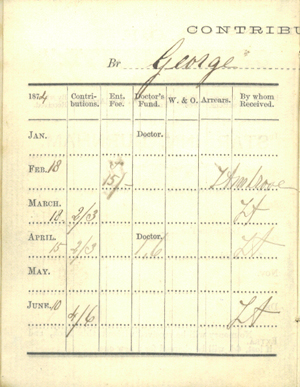
In the Trust’s collection there are many items that cannot readily be put into a recognisable category. Thus, this Ephemera page includes a wide ranging assembly of items, each a part of the AOF heritage in its own distinctive way. Some show a connection to a wider world, others to administrative arrangements within the Order. In some we can see pleasure, in others sorrow. Together they illustrate effectively that the world of the friendly society was not in isolation from ‘real life.’
What’s special about OUR collection of ephemera?
| > | It offers an opportunity to discover diverse and otherwise hidden elements of friendly society history, in a direct, informative and rewarding way. |
Subject Headings Banners |
Further Reading None Known |
 |
 |
 |
 |
 |
 |
 |
 |
 |
 |
Penny Black Agreeing to contribute to the Rowland Hill Testimonial, delegates at the London HCM of August 1844, resolved ‘that the sum of £5 be presented, on behalf of the subscription entered into to present Rowland Hill with a testimonial of respect.’ Behind this decision lay widespread appreciation of the man who had ‘by the unselfish and tireless efforts…supported by popular demand, against the indifference of statesmen and the angry obstruction of the unreformed civil service’, established, in 1840, the Penny Post. The advantages of a postal delivery prepaid by a cheap adhesive stamp were, once in place, evident to individuals and business alike. Direct evidence for this can be found in the Ancient Order of Foresters. With a central administration communicating by formal printed reports, and supplying a wide range of essential goods for use by Courts and Districts throughout the UK, the advantage of a prepaid system was immeasurable. Seen here is the external side of a printed Address sent out by the Dewsbury EC to the Secretary of Court “Freedom”, No 314 at Hyde in Cheshire. The Report is dated May 1840, so that this item survives as an important contemporary document, the Penny Post having been introduced in April 1840. It also shows the willingness of Foresters to move with the times. |
|
| Back to Top | ||
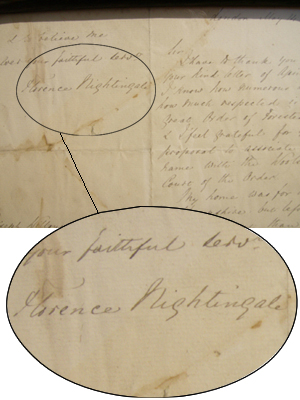 |
Florence Nightingale Signature Florence Nightingale was a 19th century personality whose name featured in every standard history of the Crimea War of 1854-6. Recent re-evaluation of her work in relation to others has brought the name back into view. Her connection with the Ancient Order of Foresters is probably amongst the least known of biographical details. Foresters’ Courts’ names were chosen by intending members of a nascent branch. They were many and varied, with trends in names emerging when foundation dates are analysed. By the late 1870’s, early 1880’s original and distinctive names were harder to choose. Intending members of a new AOF Court at Totton, Hampshire approached Florence Nightingale for permission to use her name. In her letter of reply, illustrated here, she wrote ‘I know how numerous and much respected is the great Ancient Order of Foresters…I gladly accept the honour which the Court proposes to confer on me.’ In the summer of 1880, the Dublin EC granted a dispensation for Court “Florence Nightingale”, No. 6694 of the AOF. It was a successful Court, surviving until January 1968, when it amalgamated with Court “Rose of Bitterne”, No.5009. |
|
| Back to Top | ||
 |
1909 Calendar 1909 was year of great concern to the Foresters’ and to all traditional friendly societies. In the previous year state pensions had been introduced by a Liberal Government, causing great concern to those who were, in the words of Bro Pratt Walker, HCR, ‘anxious to maintain, as far as possible, the principles upon which our movement rests … felt, in the interests of the deserving poor among our aged people, that we ought not to take up a position of hostility to the Government proposals.’ No sooner had the Glasgow EC taken office in August 1908 ‘when paragraphs began to appear in the press hinting that Government were considering the question of compulsory insurance.’ The Glasgow EC, under the chairmanship of Bro. John Brown, featured on the accompanying calendar illustration, experienced a year of watchfulness, debate and anguish. The merits and disadvantages of the state conducting insurance business received full attention, with, in due course, the Government introducing a compulsory scheme for some working people, whilst utilising the existing structures of friendly societies and other organisations as ‘Approved Societies’ to do it's work for it. |
|
| Back to Top | ||
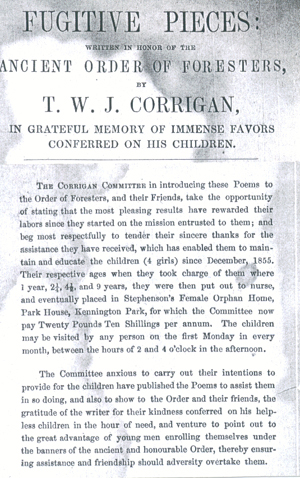 |
Corrigan's Fugitive Pieces Thomas Corrigan was a member of AOF Court “Industry”, No 1752, whose meeting place was the Prince of Wales, Banner Street, St Lukes in Middlesex, just outside the City of London. In 1855 he was detained in connection with the murder of his wife. Subsequently convicted he was transported to a penal colony in Australia. His arrest left four young daughters destitute, a situation brought to the attention of the London United District delegates meeting in January 1856. They agreed to circulate a petition amongst all LUD courts for financial aid, which would be passed to a Committee comprising members of Court “Industry” so that they could provide practical assistance for the four children. The girls, Jane, Lou(isa), Harriet and Elizabeth, were placed in Stephenson’s Female Orphan Home, Park House, Kennington Park, the Committee paying £20 10s (£20.50) per annum for their upkeep. In recognition of this humane effort, Thomas Corrigan wrote a number of poems, which were assembled by the Committee into a little booklet, with the evocative title ‘Fugitive Pieces’, which was sold at sixpence to raise money. Shown here is a composite of the title page and the wording on the inside cover. Together they reveal the efforts made and the compassion shown by Foresters towards a fellow member and his offspring, and his gratitude. |
|
| Back to Top | ||
 |
Woolsthorpe Parade Parades formed an integral part of the colourful nature of the AOF and other friendly societies. The most regular of these was the Anniversary Parade at Whitsun or in Wakes week. Initially all Courts had an anniversary date, compulsory for members to attend, on pain of being fined for non-attendance. Soon made optional, such events made an impact as Foresters, the more enthusiastic dressed in Merrie Men outfits, and bands, with their supporters, paraded through the streets of towns and villages. At their head, as in this example at Woolsthorpe-by-Belvoir, Lincolnshire, dated 1920, came the Court Banner, carried by two capable members bearing long wooden support poles. To the front and rear, members holding ropes attached to the banner gave stability, especially when a gust of wind blew. Also just visible in this photo is a member carrying the Court Dispensation, presumably with strong cord around his neck. Alongside are the Court officers, wearing their sashes, with two of them, the beadles, carrying ritual clubs. Behind, the village band, sometimes directly associated with a Court, plays a tune to keep everyone in step, followed by Court members. A second banner comes next, and after that two formations of ladies and children, from Woolsthorpe’s AOF female court and two Foresters’ Juvenile Societies complete the scene. |
|
| Back to Top | ||
 |
Funeral Orations Members honoured the memory of departed brother Foresters by formulating two Addresses to be read on the occasion of a funeral. One was intended to be read at the house, the other at the grave. The original versions were included in the Chief Ranger’s Duty in the Ceremony and Initiation and the Lectures of the Ancient Order of Foresters, adopted for use at the High court Meeting of 1836. Modified periodically, the Funeral addresses were eventually separated from other aspects of what became known as the Formularies and Lectures by decision of delegates at the Brighton HCM of 1859. A separate funeral ceremony book, priced at 4d (2p) became available, although the format of the Addresses appears to have remained as hitherto. Reproduced here is the version contained in the 1857 revised Formularies and Lectures, subsequently contained in the 1859 funeral book. The subjoined note referring to obtaining prior consent of the officiating Clergymen is a reminder that some clergymen, of varying beliefs, had problems with accepting the performance of, in their eyes, unauthorised practices, such as Foresters grave-side Addresses. They were in the minority, with the majority accepting, even supporting and participating in the work of friendly societies.
|
|
| Back to Top | ||
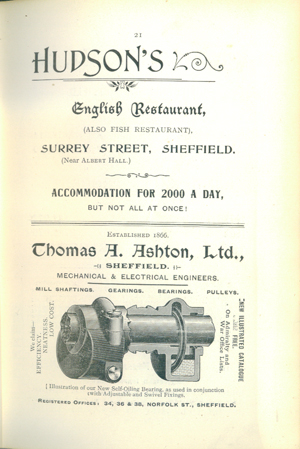 |
High Court Meeting Venue Guides Who says Yorkshirefolk don’t have a sense of humour? In this High Court Guide to Sheffield in 1903, an advert for a local restaurant anticipates accommodating some 2000 customers, but not all at one time! In fact the number of delegates to the High Court that year was 833, so that with wives and/or ‘sweethearts’ certainly over 1000 hungry people could have descended on Hudson’s English Restaurant after a long day’s debate. These Guides were a combination of local public relations and recognition of the tremendous effort made by local Foresters, and indeed fellow members of kindred societies, to make delegates’ visits as comfortable as possible. High Court [Reception] Committees were formed to make all the arrangements, and quite rightly, they would be pictured in the Guides. Other photographs included local dignatories, such as Mayors, religious post-holders, etc., From the local point of view, the large circulation of a Guide could reap benefit to advertisers, something not overlooked by the publishers. The Sheffield Guide contains over fifty advertisements. Often accompanied by a potted history of the location, an affixed map, and suggested walks or excursions, Guides were remarkably comprehensive, providing a useful insight into the nature of a High Court Meeting venue. |
|
| Back to Top | ||
(Left portion of card shown only) |
Members Contribution Card Verification of regular payment of contributions was significant, since, if a member fell behind in his contributions for a specified length of time, suspension, then ultimately exclusion, could follow, The format of the document illustrated here included the local Court Rules and a certificate of membership confirming his initiation into the AOF. The document belonged to a George Harris, a resident of Burnham in Essex. From the content, aspects of his AOF membership can be elicited. Firstly as plain Mr Harris, he paid his initial entrance fee of 15 shillings (75p) on February 18th 1874. T(homas) Ambrose, Court Secretary, signed the card acknowledging receipt of this amount. At this meeting Mr Harris’s name was proposed as a member. One month later, on being initiated, he became Bro. Harris, a member in the AOF Court “Unity”, No. 5340. His first monthly contribution, duly recorded, was 2s 3d (11p). In April the first payment of 1s 6d (7.5p) to the Doctor’s fund was made, becoming eligible for such services as the Court Rules stipulated. Possibly still a single man, Bro Harris did not at this time make any payment to a Widow and Orphan’s Fund. Should he fall sick Bro Harris was entitled to 14s (70p) per week sick pay, however eligibility for this was not until 12 months had passed from initiation date. After 26 weeks at 14s (70p), sick pay dropped to 7s (35p) per week for the next 26 weeks. After this it reduced again to 5s (25p) and continued at this level indefinitely. |
|
| Back to Top | ||
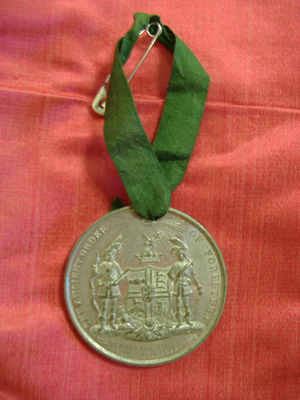 |
Crystal Palace Comm. Medal 1855 On Monday 28th August 1855, the London United District of the Ancient Order of Foresters conducted their first benefit at the relocated ‘Crystal Palace’ at Penge, Kent. The mere fact of its happening, let alone that nearly 29,000 people attended, is all the more remarkable when it is borne in mind that on July 5th 1855 ‘after some discussion’ the delegates meeting resolved that a Committee should be appointed…with a view to getting up a benefit for the district. The benefit that year was the first of a succession that continued through into the 1880’s. From available statistics, the most popular year was, strangely 1862, the year after the death of Prince Albert, when over 83,000 people attended. The event could not have been the success it was without the existence of the railway companies. They laid on excursions from various parts of the country, making this a good day out for Foresters and their families. The surplus made on the event was put to good use by members of the London United District. Initially going to the Widows and Orphan Fund, after its demise the Funeral Fund benefitted. Following the success of the Foresters’, the Oddfellows (MU) subsequently established their own outings to the Crystal Palace. |
|
| Back to Top |
